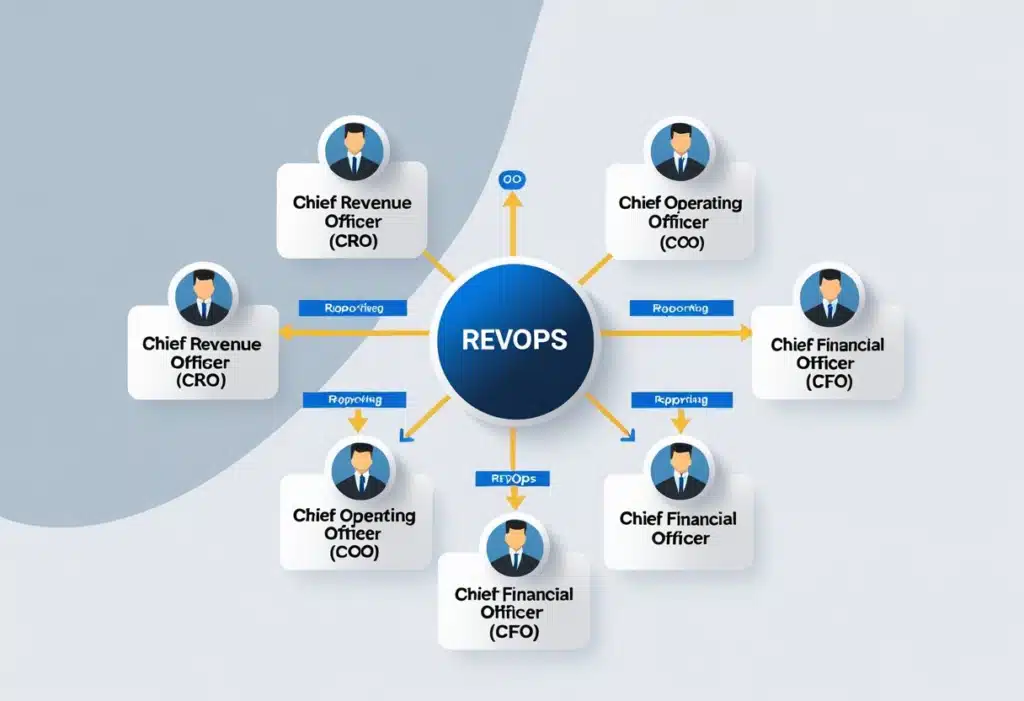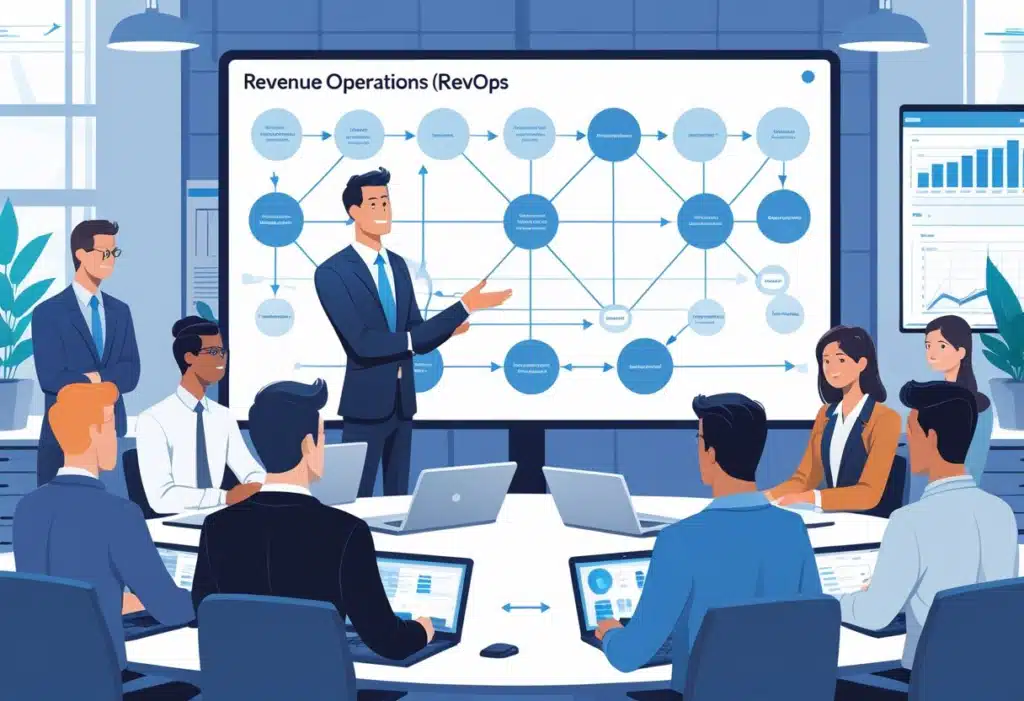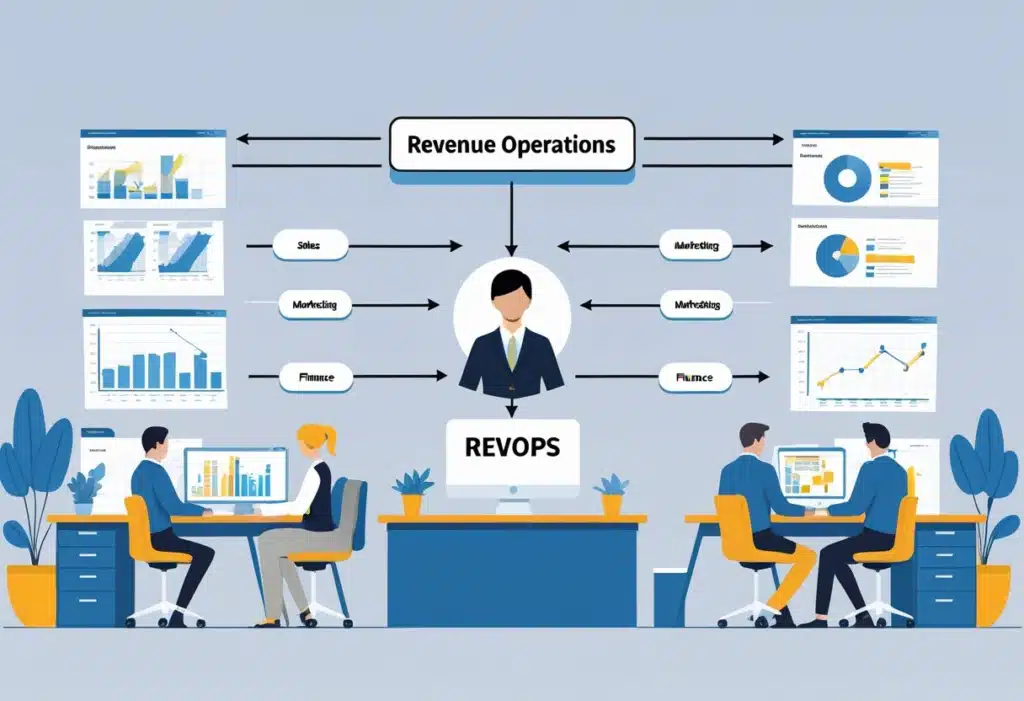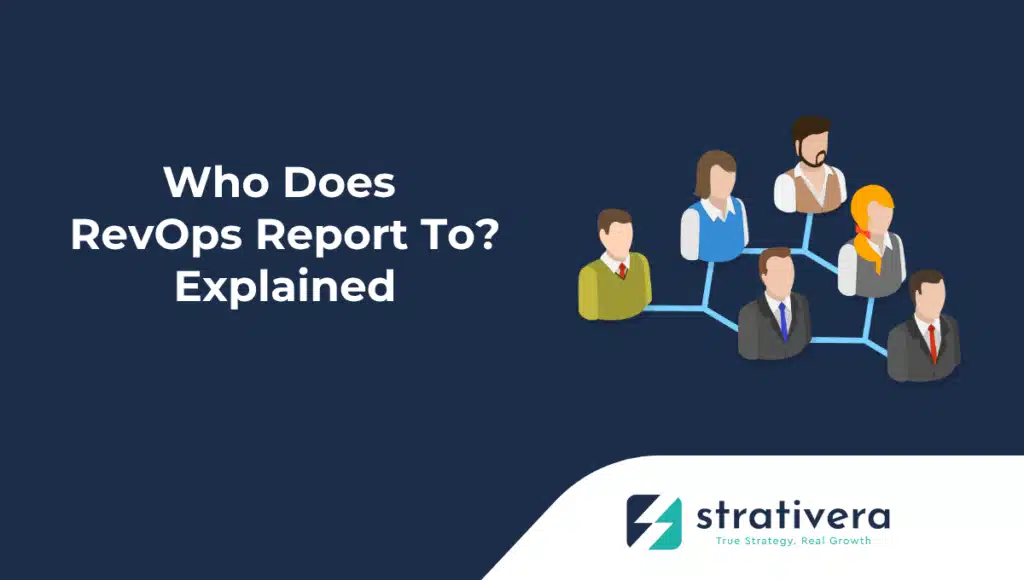Table of Contents
Revenue Operations has quickly become a must-have for companies trying to get their marketing, sales, and customer success teams on the same page. Still, one big question keeps coming up: who should RevOps actually report to?
The most effective RevOps reporting structure usually puts the team under a Chief Revenue Officer (CRO). The CRO oversees all revenue-generating functions and can break down those pesky silos that make cross-functional teamwork such a headache.

The reporting structure you pick really matters. It shapes how well RevOps can do its main job: getting go-to-market teams aligned.
If you put RevOps under the wrong leader, you might run into conflicts of interest or lose access to important data. Suddenly, your RevOps team can’t drive the changes you need across departments, and everything slows down.
This isn’t a simple decision. You have to think about company size, your current leadership setup, and what you’re actually trying to achieve.
Knowing your options—and their trade-offs—helps you get the most out of your RevOps investment. Trends are changing fast, so it pays to stay informed if you want real, lasting revenue growth.
Who Does RevOps Report To?

RevOps reporting structures look different everywhere you go. Most successful companies put RevOps leaders under a Chief Revenue Officer, Chief Operating Officer, or Chief Financial Officer.
Executive sponsorship is huge. You need someone at the top who can stay neutral and has the authority to cross department lines.
Typical Reporting Lines for RevOps
The most effective structure usually places the VP of Revenue Operations under the Chief Revenue Officer. The CRO also manages marketing, sales, and customer success leadership, so RevOps gets a seat at the table with other big players.
Primary Reporting Options:
| Reporting Role | Advantages | Considerations |
|---|---|---|
| Chief Revenue Officer | Direct alignment with revenue goals, neutrality across functions | Requires mature organizational structure |
| Chief Operating Officer | Access to IT and operational resources | May dilute focus on revenue-specific initiatives |
| Chief Financial Officer | Strong financial modeling and budget authority | Less emphasis on operational execution |
If your company doesn’t have a CRO, reporting to the COO or CFO works too. The COO route is handy because it keeps RevOps close to the tech and process resources it needs.
CFO reporting makes sense if your business has complex financial models or leans heavily on product-led growth. That setup can tighten up deal desk operations and approval policies.
Reporting to department heads like VP of Sales or CMO? That’s usually a bad move. It puts RevOps in a spot where it has to pick sides, which defeats the whole purpose of cross-functional alignment.
Executive Sponsorship and Support
Executive sponsorship is what really makes or breaks RevOps. The executive in charge needs to stay neutral and have the clout to keep everyone playing by the same rules.
RevOps leaders rely on execs who get that RevOps exists for the company as a whole, not just one department. That kind of backing becomes a lifesaver when you’re rolling out compliance policies, setting KPIs, or managing budgets that might not make everyone happy.
Critical Support Elements:
- Policy Enforcement: Executive power to push through cross-team processes
- Budget Authority: Direct say over tech and hiring
- Conflict Resolution: Neutral ground for department turf wars
- Strategic Alignment: Ties RevOps projects to big-picture company goals
If RevOps doesn’t have real executive support, the team ends up getting pressured to fudge data or ignore compliance just to hit short-term targets. Strong sponsorship keeps things honest and focused on what’s best for the company long-term.
The leader in charge also needs to understand how broad and complex RevOps really is. If a company treats RevOps like a one-person job, burnout is almost guaranteed.
Centralized vs Decentralized Reporting Structures
Centralized RevOps means you put all revenue operations functions under one leader and department. This setup gives you the clearest view across teams and keeps processes consistent.
Centralized Structure Benefits:
- Unified data standards and reporting
- Consistent tool rollouts
- Smoother process development
- Clear accountability for results
Decentralized structures, on the other hand, keep separate operations teams inside marketing, sales, and customer success. These teams coordinate through matrix reporting or just regular check-ins. It’s a model that fits bigger organizations with lots of products or locations.
Decentralized Structure Benefits:
- Deep expertise for each department
- Faster rollout of department-specific solutions
- Less coordination overhead for day-to-day stuff
- Can be useful during big company transitions
More companies are choosing centralized RevOps, especially those with product-led growth. These businesses need RevOps to support more than just sales and marketing.
Hybrid models are popping up too. Here, core RevOps functions like data and process design stay centralized, but the actual execution happens in each department. You need strong governance and clear roles to make this work without drama.
The best structure really depends on your size, growth stage, and how complicated your operations are. There’s no universal answer, but you can’t ignore these factors.
Options for RevOps Reporting Structure

Most organizations pick from three main reporting structures for their RevOps teams. Each one has its own perks, depending on your size, priorities, and how mature your company is.
Reporting to the CEO
Putting RevOps right under the CEO gives the function the most strategic influence and authority to cut across departments. This setup is best for companies that see RevOps as a strategic powerhouse, not just a support team.
Key Benefits:
- Direct line to executive decisions
- More power to enforce processes everywhere
- Clear mandate for cross-team projects
- Higher status in the company
This reporting line wipes out the conflicts you get when RevOps reports to just one department. The CEO can stay neutral and keep RevOps objective across sales, marketing, and customer success.
Companies without a COO often go this route. It sends a clear message: revenue operations matter here. But it only works if the CEO actually understands RevOps and supports its decisions.
Reporting to the CRO
Chief Revenue Officers and RevOps are a natural fit, which is why this structure is so popular in revenue-driven companies. CROs get both the technical and strategic sides of revenue generation.
Advantages include:
- Deep revenue expertise: CROs talk the same language as RevOps
- Strategic alignment: The focus stays on revenue growth
- Process understanding: CROs know how sales and marketing work
- Executive influence: Easy access to C-suite decisions
This setup really shines when the CRO oversees several revenue-generating teams. The CRO can offer tactical advice without losing sight of big-picture revenue goals.
When RevOps reports to the CRO, you get consistent messaging and priorities across all revenue functions. Everyone’s focused on the same metrics, which keeps things running smoothly.
Reporting to the COO
Chief Operating Officers bring a different angle—operational know-how and a cross-functional view. This approach focuses more on process improvement and efficiency across revenue teams.
Primary benefits:
- Operational focus: COOs are all about process improvements
- Cross-functional experience: They know how to get departments working together
- Resource allocation: COOs can move resources where they’re needed
- Scalability expertise: They’re used to handling complex growth
COOs usually manage a bunch of operational areas, so RevOps gets a bigger-picture view. That helps the team see how revenue operations fit into everything else.
If you already have a strong COO, this structure can balance operational support with strategic oversight. The COO can also protect RevOps from department politics and keep things aligned with overall business operations.
This approach is great for companies that want to nail process consistency and operational excellence.
Factors Influencing Reporting Decisions
The best RevOps reporting structure really hinges on company maturity and how complicated your revenue model is. Younger companies usually have RevOps report to the CEO because they just don’t have the resources for more layers of leadership.
Company Size and Stage
Early-stage companies almost always put RevOps under the CEO. They don’t have the budget for lots of execs, and often leaders wear multiple hats.
The CEO route works at this stage because:
- There aren’t many silos yet
- Revenue plans need instant executive buy-in
- Teams coordinate easily since everyone’s close
Growth-stage companies hit a crossroads. They have to decide if they’ll stick with CEO reporting or bring in specialized execs like a CRO or COO.
At this point, many companies don’t have a CRO yet, so they go with CFO or COO reporting. CFOs are a good fit when deal approvals and financial compliance are top priorities.
Enterprise organizations usually add dedicated CROs to handle complex revenue ops. At this size, putting RevOps under a VP of Sales just creates silos and kills cross-team effectiveness.
Business Model Considerations
SaaS companies with subscription models need RevOps structures that juggle acquisition, expansion, and retention across long customer lifecycles. The reporting line should keep equal focus on marketing lead quality, sales conversion rates, and customer success retention.
Transactional businesses usually do better with sales-oriented reporting, since deal velocity and conversion optimization drive quick revenue. But this setup can overlook long-term customer value, which feels like a miss if you ask me.
Complex enterprise sales environments need RevOps leaders who can actually enforce processes throughout those endless deal cycles. CRO reporting gives the executive backing you need when sales teams push back on compliance or standardized methods.
Multi-product companies deal with extra complexity, so they need RevOps leaders who can prioritize competing departmental demands without bias. Functional reporting often falls apart because department heads naturally push for their own product lines or customer segments.
Impact of Reporting Line on RevOps Effectiveness
The reporting structure shapes RevOps team access to critical data and decision-making power across revenue functions. RevOps effectiveness really depends on its spot in the hierarchy within an organization.
Collaboration Across Departments
RevOps teams hit collaboration roadblocks when reporting lines create silos. If RevOps reports to a CMO, sales teams often hold back accurate data—old marketing-sales tensions die hard.
This information gap leaves RevOps analysis incomplete and strategic recommendations kind of toothless. Sales and marketing teams often butt heads, especially when they’re siloed.
Cross-functional data sharing gets better when RevOps stays neutral. Teams open up more when they don’t sense bias from RevOps.
When RevOps reports to a CFO, it creates similar issues with GTM teams. Sales and customer success worry about sharing details with finance-aligned functions because of budget scrutiny.
The reporting line should allow unbiased, solid access to all revenue-generating departments. RevOps needs to gather real insights from sales reps, marketing, and customer success without politics getting in the way.
Alignment With Revenue Goals
Revenue goal alignment changes a lot depending on who RevOps reports to. If RevOps reports to the CFO, they focus on cost reduction and efficiency, not so much on revenue growth.
This financial focus limits RevOps’ impact on pipeline velocity and conversion. The CFO wants budget cuts and team efficiency, which can clash with growth-focused revenue teams.
CRO-aligned RevOps teams show stronger alignment with revenue goals. They get full access to the revenue funnel and can influence decisions across marketing, sales, and customer success all at once.
Pipeline efficiency and conversion velocity usually improve when RevOps sits in a revenue-focused structure. If you care about pipeline efficiency, conversion speed, and coordinated plays, CRO reporting is usually the best fit.
CEO-reporting RevOps has the ultimate alignment on revenue goals, but as companies grow, the CEO’s attention gets pulled in too many directions. That can slow down RevOps’ strategic focus and execution.
Evolving Trends in RevOps Reporting
RevOps reporting is shifting toward more strategic, C-level positions as businesses see revenue operations as a growth driver, not just a support function. The rise of RevOps to the C-suite shows organizations want integrated revenue strategy and cross-functional alignment.
Growth of Strategic RevOps Roles
Revenue Operations has gone from tactical support to a strategic business must-have. RevOps isn’t a luxury anymore—it’s a necessity for companies chasing sustainable growth in 2025.
Organizations finally recognize RevOps as the key to breaking down silos. The function now covers all customer-facing teams, not just sales ops.
Key strategic responsibilities now include:
- Cross-functional revenue planning and forecasting
- Technology stack optimization and integration
- Data-driven decision making across GTM teams
- Revenue process standardization and automation
This new importance changes where RevOps pros sit in the org chart. Companies are putting RevOps leaders closer to executive decision-makers.
Businesses get that revenue operations needs authority across the enterprise. RevOps teams need executive backing to roll out changes across departments and drive real transformation.
Future Outlook for RevOps Reporting Lines
Traditional structures with RevOps under CRO or CSO are shifting toward CEO reporting as businesses get more complex. RevOps influence is spreading beyond just revenue teams.
Emerging reporting preferences show:
- More RevOps leaders reporting directly to the CEO
- COO reporting in operationally-focused companies
- CFO alignment in data-driven, PLG organizations
- Board-level visibility for strategic RevOps initiatives
Product-led growth companies especially like CFO or COO reporting. These models admit that every department plays a part in revenue in today’s business world.
The move toward higher-level reporting shows how strategic RevOps has become. Organizations know that effective revenue operations needs unbiased authority and cross-functional influence.
Companies without a COO often put RevOps right under the CEO. That gives maximum authority and keeps things objective across all revenue functions.
FAQs – Who Does RevOps Report To
Revenue Operations reporting structures vary a lot, with different execs overseeing these functions depending on company size and strategic priorities. Compensation and collaboration models also change based on hierarchy and how integrated the teams are.
What is the typical reporting structure for Revenue Operations within an organization?
RevOps pros usually report to different execs depending on company structure and size. The most common setup is reporting to the CRO, since this exec oversees the whole revenue process from marketing through customer success.
In smaller companies, RevOps might report to a VP of Sales who handles everything revenue-related. As companies grow, this often shifts to direct CRO reporting to avoid conflicts of interest.
Some companies have RevOps report to the CFO, especially in product-led growth companies where all departments contribute to revenue. The COO is another option if there’s strong alignment with the CRO.
CEO reporting usually happens in early-stage companies. This structure changes as the organization scales and brings in specialized revenue leadership roles.
How do responsibilities differ between RevOps and traditional sales or finance roles?
RevOps aligns all go-to-market teams toward shared goals, while sales focuses on direct customer acquisition and closing deals. Sales teams drive revenue activities; RevOps builds and optimizes the systems that make those activities possible.
Finance usually handles cost management, budget allocation, and financial reporting. RevOps steps in with operational insights that drive revenue growth, not just financial metrics.
Finance often chases efficiency through cutting costs. RevOps looks for revenue optimization through better processes and cross-functional teamwork.
The RevOps role bridges gaps between siloed departments. Traditional roles stay in their own lanes, but RevOps works across marketing, sales, and customer success.
What is the role of a VP of Revenue Operations in a corporate hierarchy?
A VP of Revenue Operations typically sits at the senior leadership level, reporting directly to C-suite execs like the CRO or CEO. This role oversees strategic alignment of all revenue-generating functions.
The VP manages teams for sales ops, marketing ops, and customer success ops. They make sure these teams actually work together, not just in their own bubbles.
This job involves setting revenue targets, rolling out process improvements, and creating metrics to track performance across the revenue funnel. The VP also works with other senior leaders on go-to-market strategies.
In bigger companies, the VP of RevOps might oversee several directors or managers for specific operational areas. They act as the main link between ops teams and executive leadership for revenue initiatives.
How does a well-integrated RevOps team influence company scalability and success?
Well-integrated RevOps teams get rid of inefficiencies caused by silos, helping companies scale revenue ops faster. They set up processes that can actually be repeated as the company grows.
These teams offer data-driven insights that help leaders make smart calls about resources and strategy. This visibility speeds up growth by spotting bottlenecks and optimization opportunities early on.
RevOps integration makes the customer experience smoother by ensuring clean handoffs between marketing, sales, and customer success. This seamless approach boosts customer retention and lifetime value.
When RevOps gets everyone aligned, companies cut operational costs and increase revenue efficiency. You can scale more profitably when all revenue teams aim for the same objectives.
In what ways does RevOps collaboration with HR or Finance departments enhance overall operations?
When RevOps teams work with HR, they improve hiring for revenue roles by sharing data on team performance and capacity needs. This partnership helps bring in the right talent at just the right time for growth.
Working with Finance means better budget planning, thanks to detailed revenue forecasting and operational metrics. RevOps gives finance teams the operational context they need to understand spending for growth initiatives.
HR partnerships help set up comp structures and performance metrics that actually tie to revenue goals. This way, individual incentives line up with bigger company objectives.
Finance collaboration also improves cash flow management by providing accurate pipeline data and conversion metrics. That info helps finance plan for expenses and smart investments.
What are the key factors to consider when determining the salary range for a Head of Revenue Operations?
Company size matters a lot here. Larger organizations usually pay more for Head of RevOps roles, while startups or mid-market businesses might not match those numbers.
Enterprise companies tend to offer premium rates. The difference can be pretty striking if you compare them to smaller players.
Location is another huge factor. Major metro areas and tech hubs almost always bring higher salaries.
If the company allows remote work, that can shift things too. Sometimes, it blurs those geographic lines a bit, but it doesn’t erase them.
Industry sector? Absolutely critical. Tech, financial services, and other fast-growing industries are known for paying more than old-school sectors.
Experience level and a solid record of revenue impact go hand in hand with higher pay. Folks who’ve actually scaled revenue ops can ask for—and usually get—more.
Reporting structure makes a difference as well. If the role reports directly to the CEO or CRO, expect the salary to go up compared to reporting to someone lower down.

